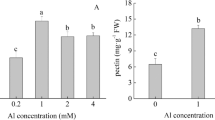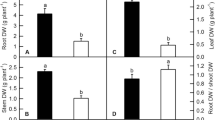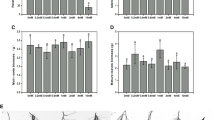Abstract
Tea plants (Camellia sinensis (L.) Kuntze) can hyperaccumulate fluoride (F−) without any toxic symptom, especially in mature leaves. However, the molecular mechanism of absorption and hyperaccumulation of F− was poorly understood in C. sinensis. Here, a transcriptomic analysis was performed to compare the responses to fluoride stress of tea leaves to understand F− accumulation and its influence on gene expression in C. sinensis leaves. The results indicated that numerous differentially expressed genes involved in ion absorption and transport exist in the process of F− absorption in C. sinensis leaves. The up-regulated expression of genes associated with uptake and transport of Ca2+ and K+ (CNGC, TPC1, CAX, and VHA) increased the intracellular and vacuole cation concentration during F− accumulation in C. sinensis leaves. We also found that some of AQP (PIPs and TIPs) genes may promote F− into the intracellular spaces and vacuoles in C. sinensis leaves, respectively. In addition, F− induced the expression of differential genes related to plant hormone metabolism and signaling pathways (ABA, auxin, and GA). Subsequently, a lot of transcription factors (WRKY, MYB, NAC, bHLH and AP2/ERF) were activated to respond to F− stress in tea leaves by regulating plant hormone signal transduction and other pathways. And ubiquitin systems were involved in the regulation of proteins homeostasis under F− stress indicating that they are responsible for the response of C. sinensis leaves to F−. Overall, these findings provide a comprehensive understanding of the F− absorption mechanism and its influence on gene expression in tea leaves.







Similar content being viewed by others
References
Achard P, Renou JP, Berthome R, Harberd NP, Genschik P (2008) Plant DELLAs restrain growth and promote survival of adversity by reducing the levels of reactive oxygen species. Curr Biol 18:656–660. https://doi.org/10.1016/j.cub.2008.04.034
Ali R, Zielinski RE, Berkowitz GA (2006) Expression of plant cyclic nucleotide-gated cation channels in yeast. J Exp Bot 57:125–138. https://doi.org/10.1093/jxb/erj012
Banerjee A, Roychoudhury A (2019) Melatonin application reduces fluoride uptake and toxicity in rice seedlings by altering abscisic acid, gibberellin, auxin and antioxidant homeostasis. Plant Physiol Biochem 145:164–173. https://doi.org/10.1016/j.plaphy.2019.10.033
Banerjee A, Singh A, Roychoudhury A (2019) Spermidine application reduces fluoride uptake and ameliorates physiological injuries in a susceptible rice cultivar by activating diverse regulators of the defense machinery. Environ Sci Pollut Res Int 26:36598–36614. https://doi.org/10.1007/s11356-019-06711-9
Bihler H, Eing C, Hebeisen S, Roller A, Czempinski K, Bertl A (2005) TPK1 is a vacuolar ion channel different from the slow-vacuolar cation channel. Plant Physiol 139:417–424. https://doi.org/10.1104/pp.105.065599
Cai H, Dong Y, Li Y, Li D, Peng C, Zhang Z, Wan X (2016) Physiological and cellular responses to fluoride stress in tea (Camellia sinensis) leaves. Acta Physiol Plant. https://doi.org/10.1007/s11738-016-2156-0
Callis J (2014) The ubiquitination machinery of the ubiquitin system. Arabidopsis Book 12:e0174. https://doi.org/10.1199/tab.0174
Cui MH et al (2013) An Arabidopsis R2R3-MYB transcription factor, AtMYB20, negatively regulates type 2C serine/threonine protein phosphatases to enhance salt tolerance. FEBS Lett 587:1773–1778. https://doi.org/10.1016/j.febslet.2013.04.028
Das C, Dey U, Chakraborty D, Datta JK, Mondal NK (2015) Fluoride toxicity effects in potato plant (Solanum tuberosum L.) grown in contaminated soils. Octa J EnvironRes 3(2):136–143
Erpen L, Devi HS, Grosser JW, Dutt M (2017) Potential use of the DREB/ERF, MYB, NAC and WRKY transcription factors to improve abiotic and biotic stress in transgenic plants. Plant Cell Tissue Organ Cult (PCTOC) 132:1–25. https://doi.org/10.1007/s11240-017-1320-6
Fung KF, Wong MH (2001) Effects of soil pH on the uptake of Al, F and other elements by tea plants. J Sci Food Agric 82(1):146–152. https://doi.org/10.1002/jsfa.1007
Fung KF, Zhang ZQ, Wong JWC, Wong MH (1999) Fluoride contents in tea and soil from tea plantations and the release of fluoride into tea liquor during infusion. Environ Pollut. https://doi.org/10.1016/s0269-7491(98)00187-0
Hauser F, Waadt R, Schroeder JI (2011) Evolution of abscisic acid synthesis and signaling mechanisms. Curr Biol 21:R346-355. https://doi.org/10.1016/j.cub.2011.03.015
Hong B, Tong Z, Ma N, Li J, Kasuga M, Yamaguchi-Shinozaki K, Gao J (2006) Heterologous expression of the AtDREB1A gene in chrysanthemum increases drought and salt stress tolerance. Sci China Ser C Life Sci 49:436–445. https://doi.org/10.1007/s11427-006-2014-1
Huang X, Song XW, Chen YQ (2016) Advances in Fluorine absorption and accumulation mechanisms in tea plant. J Tea Sci 36:551–556 (Chinese)
Kim MC, Chung WS, Yun DJ, Cho MJ (2009) Calcium and calmodulin-mediated regulation of gene expression in plants. Mol Plant 2:13–21. https://doi.org/10.1093/mp/ssn091
Kourghi M, Pei JV, De Ieso ML, Nourmohammadi S, Chow PH, Yool AJ (2018) Fundamental structural and functional properties of Aquaporin ion channels found across the kingdoms of life. Clin Exp Pharmacol Physiol 45:401–409. https://doi.org/10.1111/1440-1681.12900
Kudla J, Batistic O, Hashimoto K (2010) Calcium signals: the lead currency of plant information processing. Plant Cell 22:541–563. https://doi.org/10.1105/tpc.109.072686
Li S, Smith KD, Davis JH, Gordon PB, Breaker RR, Strobel SA (2013) Eukaryotic resistance to fluoride toxicity mediated by a widespread family of fluoride export proteins. Proc Natl Acad Sci USA 110:19018–19023. https://doi.org/10.1073/pnas.1310439110
Li QS, Lin XM, Qiao RY, Zheng XQ, Lu JL, Ye JH, Liang YR (2017) Effect of fluoride treatment on gene expression in tea plant (Camellia sinensis). Sci Rep 7:9847. https://doi.org/10.1038/s41598-017-08587-6
Liu W, Tai H, Li S, Gao W, Zhao M, Xie C, Li WX (2014) bHLH122 is important for drought and osmotic stress resistance in Arabidopsis and in the repression of ABA catabolism. New Phytol 201:1192–1204. https://doi.org/10.1111/nph.12607
Livak KJ, Schmittgen TD (2001) Analysis of relative gene expression data using real-time quantitative PCR and the 2-ΔΔCT method. Methods 25:402–408. https://doi.org/10.1006/meth.2001.1262
Lu Y, Guo WF, Yang XQ (2004) Fluoride content in tea and its relationship with tea quality. J Agric Food Chem 52:4472–4476. https://doi.org/10.1021/jf0308354
Lyzenga WJ, Stone SL (2012) Abiotic stress tolerance mediated by protein ubiquitination. J Exp Bot 63:599–616. https://doi.org/10.1093/jxb/err310
McAinsh MR, Pittman JK (2009) Shaping the calcium signature. New Phytol 181:275–294. https://doi.org/10.1111/j.1469-8137.2008.02682.x
Morales JML, Gabriela SJ (2012) Oxidative damage caused by copper and the antioxidant response of plants. Interciencia 37:805–811
Nevo Y, Nelson N (2006) The NRAMP family of metal-ion transporters. Biochem Biophys Acta 1763:609–620. https://doi.org/10.1016/j.bbamcr.2006.05.007
O’Neill DP et al (2010) Regulation of the gibberellin pathway by auxin and DELLA proteins. Planta 232:1141–1149. https://doi.org/10.1007/s00425-010-1248-0
Park MY, Kang JY, Kim SY (2011) Overexpression of AtMYB52 confers ABA hypersensitivity and drought tolerance. Mol Cells 31:447–454. https://doi.org/10.1007/s10059-011-0300-7
Pei ZM et al (2000) Calcium channels activated by hydrogen peroxide mediate abscisic acid signalling in guard cells. Nature 406:731–734. https://doi.org/10.1038/35021067
Peiter E, Maathuis F, Mills L et al (2005) The vacuolar Ca2+-activated channel TPC1 regulates germination and stomatal movement. Nature 434:404–408. https://doi.org/10.1038/nature03381
Pottosin II, Schonknecht G (2007) Vacuolar calcium channels. J Exp Bot 58:1559–1569. https://doi.org/10.1093/jxb/erm035
Qin Y, Wang M, Tian Y, He W, Han L, Xia G (2012) Over-expression of TaMYB33 encoding a novel wheat MYB transcription factor increases salt and drought tolerance in Arabidopsis. Mol Biol Rep 39:7183–7192. https://doi.org/10.1007/s11033-012-1550-y
Rodrigues AA, Vasconcelos-Filho SC, Mendes GC, Rehn LS, Rodrigues DA, Rodrigues CL, Müller C (2017) Fluoride in simulated rain affects the morphoanatomy and physiology of Eugenia dysenterica (Mart.) DC. Ecol Indic 82:189–195. https://doi.org/10.1016/j.ecolind.2017.07.005
Ruan J, Wong MH (2001) Accumulation of fluoride and aluminium related to different varieties of tea plant. Environ Geochem Health 23:53–63. https://doi.org/10.1023/a:1011082608631
Ruan J, Ma L, Shi Y, Han W (2003) Uptake of fluoride by tea plant (Camellia sinensis L.) and the impact of aluminium. J Sci Food Agric 83:1342–1348. https://doi.org/10.1002/jsfa.1546
Ruan J, Ma L, Shi Y, Han W (2004) The impact of pH and calcium on the uptake of fluoride by tea plants (Camellia sinensis L.). Ann Bot 93:97–105. https://doi.org/10.1093/aob/mch010
Saxena S, Rani A (2012) Fluoride ion leaching kinetics for alkaline soils of Indian origin. J Sci Res Rep 1(1):29–40. https://doi.org/10.9734/JSRR/2012/2101
Schulz P, Herde M, Romeis T (2013) Calcium-dependent protein kinases: hubs in plant stress signaling and development. Plant Physiol 163:523–530. https://doi.org/10.1104/pp.113.222539
Shan H et al (2012) Heterologous expression of the chrysanthemum R2R3-MYB transcription factor CmMYB2 enhances drought and salinity tolerance, increases hypersensitivity to ABA and delays flowering in Arabidopsis thaliana. Mol Biotechnol 51:160–173. https://doi.org/10.1007/s12033-011-9451-1
Shang Y et al (2010) The Mg-chelatase H subunit of Arabidopsis antagonizes a group of WRKY transcription repressors to relieve ABA-responsive genes of inhibition. Plant Cell 22:1909–1935. https://doi.org/10.1105/tpc.110.073874
Sharma R, Kaur R (2018) Insights into fluoride-induced oxidative stress and antioxidant defences in plants. Acta Physiol Plant 40(10):181. https://doi.org/10.1007/s11738-018-2754-0
Sharma T, Dreyer I, Riedelsberger J (2013) The role of K+ channels in uptake and redistribution of potassium in the model plant Arabidopsis thaliana. Front Plant Sci 4:224. https://doi.org/10.3389/fpls.2013.00224
Sharma R, Kumari A, Rajput S, Nishu AS, Rampal R, Kaur R (2019) Accumulation, morpho-physiological and oxidative stress induction by single and binary treatments of fluoride and low molecular weight phthalates in Spirodela polyrhiza L. Schleiden. Sci Rep 9(1):20006. https://doi.org/10.1038/s41598-019-56110-w
Smith GE (1986) Fluoride, the environment, and human health. Perspect Biol Med 29:560–572. https://doi.org/10.1353/pbm.1986.0028
Stockbridge RB, Robertson JL, Ludmila KP, Christopher MJE (2013) A family of fluoride-specific ion channels with dual-topology architecture. Elife. https://doi.org/10.7554/eLife.01084
Supek F, Supekova L, Nelson H, Nelson N (1997) Function of metal-ion homeostasis in the cell division cycle, mitochondrial protein processing, sensitivity to mycobacterial infection and brain function. J Exp Biol 200:321–330. https://doi.org/10.1098/rspa.2003.1137
Wan Q, Xu RK, Li XH (2012) Proton release by tea plant (Camellia sinensis L.) roots as affected by nutrient solution concentration and pH. Plant Soil Environ 58:429–434. https://doi.org/10.17221/326/2012-PSE
Wang Y, Deng D (2014) Molecular basis and evolutionary pattern of GA-GID1-DELLA regulatory module. Mol Genet Genomics 289:1–9. https://doi.org/10.1007/s00438-013-0797-x
Wang Z, Gerstein M, Snyder M (2009) RNA-Seq: a revolutionary tool for transcriptomics. Nat Rev Genet 10:57–63. https://doi.org/10.1038/nrg2484
Wang L, Feng Z, Wang X, Wang X, Zhang X (2010) DEGseq: an R package for identifying differentially expressed genes from RNA-seq data. Bioinformatics 26:136–138. https://doi.org/10.1093/bioinformatics/btp612
Wong MH, Fung KF, Carr HP (2003) Aluminium and fluoride contents of tea, with emphasis on brick tea and their health implications. Toxicol Lett 137:111–120. https://doi.org/10.1016/s0378-4274(02)00385-5
Xing AQ, Ma YC, Wu ZC, Nong SH, Zhu JJ, Sun H, Tao J, Wen B, Zhu XJ, Fang WP, Li XC, Wang YH (2020) Genome-wide identification and expression analysis of the CLC superfamily genes in tea plants (Camellia sinensis). Funct Integr Genomics 20:497–508. https://doi.org/10.1007/s10142-019-00725-9
Yang Y, Liu Y, Huang CF, de Silva J, Zhao FJ (2016) Aluminium alleviates fluoride toxicity in tea (Camellia sinensis). Plant Soil 402:179–190. https://doi.org/10.1007/s11104-015-2787-8
Yokotani N, Ichikawa T, Kondou Y, Matsui M, Hirochika H, Iwabuchi M, Oda K (2009) Tolerance to various environmental stresses conferred by the salt-responsive rice gene ONAC063 in transgenic Arabidopsis. Planta 229:1065–1075. https://doi.org/10.1007/s00425-009-0895-5
Zhang Y, Yang CW, Li Y, Zheng NY, Chen H, Zhao QZ, Gao T, Guo HS, Xie Q (2007) SDIR1 is a RING finger E3 ligase that positively regulates stress-responsive abscisic acid signaling in Arabidopsis. Plant Cell 19:1912–1929. https://doi.org/10.1105/tpc.106.048488
Zhang XC, Gao HJ, Zhang ZZ, Wan XC (2012) Influences of different ion channel inhibitors on the absorption of fluoride in tea plants (Camellia sinesis L.). Plant Growth Regul 69:99–106. https://doi.org/10.1007/s10725-012-9751-x
Zhang L, Li Q, Ma LF, Ruan JY (2013) Characterization of fluoride uptake by roots of tea plants (Camellia sinensis (L.) O. Kuntze). Plant Soil 366:659–669. https://doi.org/10.1007/s11104-012-1466-2
Zhang XC, Gao HJ, Wu HH, Yang TY, Zhang ZZ, Mao JD, Wan XC (2015) Ca2+ and CaM are involved in Al3+ pretreatment-promoted fluoride accumulation in tea plants (Camellia sinesis L.). Plant Physiol Biochem 96:288–295. https://doi.org/10.1016/j.plaphy.2015.08.007
Zhu JJ, Pan JT, Nong SH, Ma YC, Xing AQ, Zhu XJ, Wen B, Fang WP, Wang YH (2019a) Transcriptome analysis reveals the mechanism of fluoride treatment affecting biochemical components in Camellia sinensis. Int J Mol Sci. https://doi.org/10.3390/ijms20020237
Zhu JJ, Xing AQ, Wu ZC, Tao J, Ma YC, Wen B, Zhu XJ, Fang WP, Wang YH (2019b) CsFEX, a fluoride export protein gene from Camellia sinensis, alleviates fluoride toxicity in transgenic Escherichia coli and Arabidopsis thaliana. J Agric Food Chem 67:5997–6006. https://doi.org/10.1021/acs.jafc.9b00509
Acknowledgements
This work was supported by the National Natural Science Foundation of China (31972458), the earmarked fund for Jiangsu Agricultural Industry Technology System (JATS[2020]405) and the earmarked fund for China Agriculture Research System (CARS-19).
Author information
Authors and Affiliations
Corresponding author
Ethics declarations
Conflict of interest
The authors declare that they have no conflict of interests.
Additional information
Communicated by V. P. Singh.
Publisher's Note
Springer Nature remains neutral with regard to jurisdictional claims in published maps and institutional affiliations.
Supplementary Information
Below is the link to the electronic supplementary material.
Rights and permissions
About this article
Cite this article
Pan, J., Xing, A., Zhu, J. et al. Gene expression analysis in leaf of Camellia sinensis reveals the response to fluoride. Acta Physiol Plant 43, 111 (2021). https://doi.org/10.1007/s11738-021-03283-5
Received:
Revised:
Accepted:
Published:
DOI: https://doi.org/10.1007/s11738-021-03283-5




